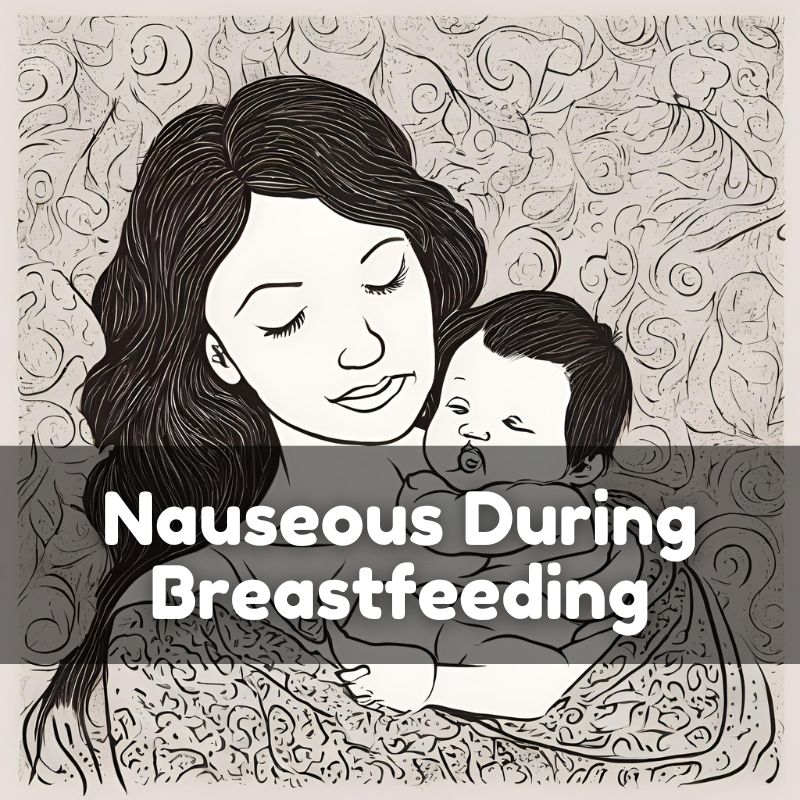
Breastfeeding is a beautiful and fulfilling experience for many new mothers, but it’s not without its challenges. One common but often overlooked issue is nausea during breastfeeding. This discomfort can disrupt the bonding experience and leave mothers feeling frustrated and anxious. In this comprehensive guide, we’ll explore the causes of nausea during breastfeeding, provide practical solutions for relief, and offer tips to make the breastfeeding journey smoother.
Understanding Nausea During Breastfeeding
Nausea during breastfeeding can be a perplexing and distressing issue. It’s essential to understand that this symptom, while not widely discussed, is a genuine concern for many new mothers. Addressing it involves identifying the underlying causes and exploring effective strategies to manage and alleviate it.
Common Causes of Nausea During Breastfeeding
Several factors may contribute to feelings of nausea during breastfeeding. Identifying these causes can help in finding appropriate solutions.
1. Hormonal Fluctuations
During the postpartum period, hormonal fluctuations are common. These changes can affect various bodily functions, including digestion and overall comfort. The release of hormones such as oxytocin, which helps with milk ejection, might also contribute to nausea in some women.
2. Dehydration
Breastfeeding increases fluid requirements, and inadequate hydration can lead to dehydration. Dehydration can cause nausea, dizziness, and general discomfort, making it essential for breastfeeding mothers to stay well-hydrated.
3. Nutritional Imbalances
A mother’s diet plays a crucial role in her well-being. Nutritional imbalances or deficiencies, such as low blood sugar or inadequate intake of essential nutrients, can cause nausea. Ensuring a balanced diet with adequate vitamins and minerals is vital for both maternal and infant health.
4. Gastrointestinal Issues
Underlying gastrointestinal issues, such as acid reflux or indigestion, may become more pronounced during breastfeeding. The physical changes in the body postpartum, combined with dietary adjustments, can exacerbate these conditions.
5. Anxiety and Stress
The transition to motherhood can be stressful, and high levels of anxiety can manifest physically. Stress can trigger nausea and other gastrointestinal symptoms, affecting a mother’s ability to enjoy breastfeeding.
Solutions and Strategies for Managing Nausea
Finding relief from nausea during breastfeeding involves addressing the root causes and implementing effective strategies. Here are some practical solutions to consider:
1. Stay Hydrated
Maintaining proper hydration is crucial for overall health and can help alleviate nausea. Aim to drink plenty of water throughout the day. Herbal teas, such as ginger or peppermint, can also be soothing and help with nausea.
2. Eat a Balanced Diet
Ensure your diet includes a variety of nutrient-dense foods. Eating small, frequent meals can help maintain stable blood sugar levels and prevent nausea. Incorporate fruits, vegetables, lean proteins, and whole grains into your meals to support overall health.
3. Manage Hormonal Fluctuations
While hormonal changes are a natural part of the postpartum period, some lifestyle adjustments can help manage symptoms. Regular exercise, adequate sleep, and stress-reducing activities can contribute to hormonal balance and overall well-being.
4. Address Gastrointestinal Issues
If gastrointestinal issues are contributing to your nausea, consider dietary adjustments and consult with a healthcare provider. Eating smaller, more frequent meals and avoiding trigger foods may provide relief. Over-the-counter medications or prescriptions may be recommended by a doctor if necessary.
5. Reduce Stress and Anxiety
Finding ways to manage stress and anxiety can significantly improve your overall comfort. Practice relaxation techniques, such as deep breathing exercises, meditation, or yoga. Joining a support group for new mothers can also provide emotional support and reduce feelings of isolation.
6. Consult with a Healthcare Provider
If nausea persists or worsens, it’s essential to consult with a healthcare provider. They can help identify any underlying medical conditions, recommend appropriate treatments, and provide personalized advice based on your specific situation.
Additional Tips for a Comfortable Breastfeeding Experience
In addition to managing nausea, here are some tips to enhance your overall breastfeeding experience:
1. Create a Comfortable Environment
Ensure that your breastfeeding area is comfortable and relaxing. Use supportive pillows and create a cozy space where you can sit back and enjoy the bonding experience with your baby.
2. Take Breaks
It’s important to listen to your body and take breaks when needed. If you’re feeling overwhelmed or uncomfortable, take a moment to rest and recharge.
3. Seek Support
Don’t hesitate to seek support from family, friends, or lactation consultants. They can provide valuable advice and encouragement, helping you navigate the challenges of breastfeeding.
4. Stay Informed
Educate yourself about breastfeeding and postpartum care. Understanding what to expect can help you better manage any issues that arise and feel more confident in your role as a mother.
Conclusion
Nausea during breastfeeding can be an unsettling experience, but understanding its causes and implementing effective strategies can provide relief and enhance your overall breastfeeding journey. By staying hydrated, eating a balanced diet, managing stress, and seeking professional advice when necessary, you can improve your comfort and enjoy the precious moments of breastfeeding with your baby. Remember, every mother’s experience is unique, so be patient with yourself and seek the support you need to make this special time as enjoyable and fulfilling as possible.
